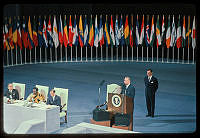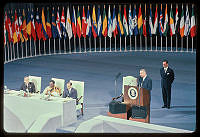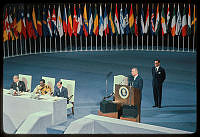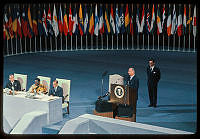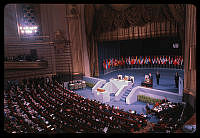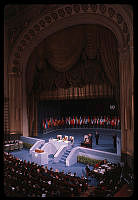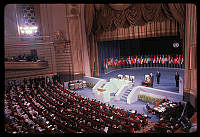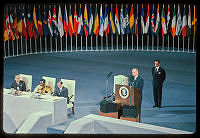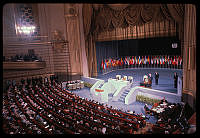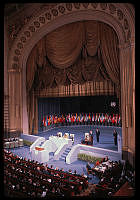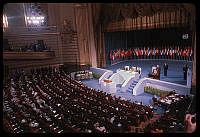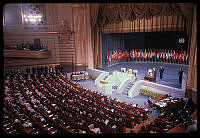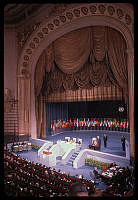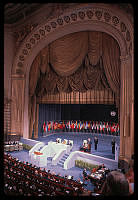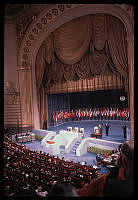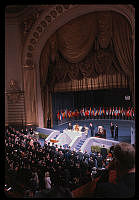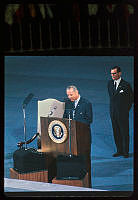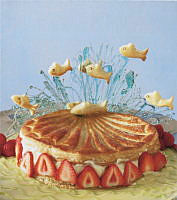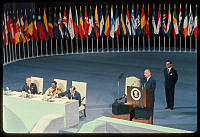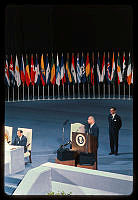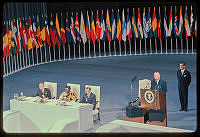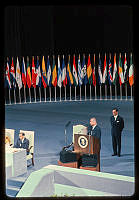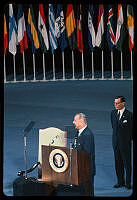Although today's mailboxes are filled with magazines, catalogs, and bills, they lack an abundance of personal letters. The technologies of the electronic age allow people to communicate quickly and efficiently without ever having to pick up a pen. Up-to-the-minute reports via telephone, television, radio, and the Internet allow us to be informed of events as quickly as they happen.
In the 18th and early 19th centuries people had far fewer means of communication available to them. A limited number of newspapers may have provided some people with local, national, and international news but letter writing was a more effective and readily available method of communication. The reasons for corresponding have not changed significantly over the centuries. A desire to keep in touch with friends, family, and colleagues who are far away has always been important, but when limited communication options were available, letter writing was also an important outlet for people to express opinions and exchange ideas on many subjects. These narratives provide insight on philosophical, religious, social, scientific or political topics not only to the intended recipient, but also to the unintended reader of today.
Letters provide an intimate and personal record of events and ideas and they must be read with a critical eye. Historians must consider the relationship between the writer and the recipient, the backgrounds of both, and the context of the time period. While historic letters cannot provide all the answers to questions of the past they do contribute a valuable perspective.
The letters in this lesson, written by President John Adams and First Lady Abigail Adams, demonstrate the power and significance of letter writing from personal and historical perspectives. Their letters are filled with personal hopes and dreams along with keen observations of the political and social landscape. They reflect the Adamses' desires to inform one another but they also reflect an understanding that these documents would serve as a record of their participation in unprecedented events for generations to come.
Download Lesson
Objectives
By reading original letters written by John and Abigail Adams at the time of their White House residency, the student will be able to:
- Analyze letters as historical documents and draw conclusions about the benefits and limitations of letters as primary source material.
- Compare letters written on the same day by Abigail Adams, to different people, and to draw conclusions about the information in each letter.
- Describe the condition of the President's House (White House) and surrounding environs in its earliest days as home and office of the chief executive.
- Cite examples that John and Abigail Adams viewed their roles as first occupants of the White House as significant for future residents.
- Reflect on the significance of the White House as a symbol of the new republic.
Background
Today, the White House is known around the world as a symbol of the power and influence of the United States. When the idea first arose to build a permanent residence for the president of the new republic, George Washington hoped that the building would be a "palace" that reflected a nation with a strong federal government, residing in a city that would one day take its place alongside the great power centers of Europe. His vision of the house, grander and more opulent than it ever would be in reality, was to be achieved not simply through ornamentation and decorative elements, but through events that shaped the nation and the leaders who would occupy the residence.
Building the President's House would not happen easily or quickly. The area now known as Washington, D.C., was designated the seat of the federal government in July 1790 with the passage of the Residence Bill. George Washington selected the site on the Potomac River. Chosen for its central geographic location, the area was largely undeveloped farms and forests. The government had ten years to transform this land into a capital city that would, among other things, reflect the ideals of the new republic. Because of politics and personalities, planning and building the federal city was a long and arduous job. For more information on "Building the White House" go to Classroom Lessons: Grades 4-8.
By the time John Adams first visited the city of Washington in June 1800, he was more than three years into his presidency. His term had not been easy. Although he succeeded George Washington as the second president of the United States, he won the office by only three electoral votes. Not only was he in conflict with his vice president and former friend, Republican Thomas Jefferson, but Adams battled members that shared his own Federalist party, the most vocal of whom was Alexander Hamilton. During a time of European war, President Adams's attempts to negotiate peace with France angered the pro-British, Hamiltonian Federalists. Passage of the Alien and Sedition Acts and the build-up of an army and navy at the prospect of going to war with France infuriated French-leaning Republicans.
Despite the political turmoil, John Adams remained true to his convictions and to what his wife Abigail called the "splendid misery" of the presidency. He also remained committed to the scheduled move of the federal government from its temporary home in Philadelphia to Washington including his own move into the President's House. With the possibility of a second term uncertain, Adams initially felt that a row house on Capitol Hill would be adequate for his stay in Washington. He changed his mind during a trip to the federal city in the summer of 1800. Accompanied by his secretary and nephew, William Shaw, Adams arrived in Washington on June 3, 1800. His visit to the President's House with the architect piqued his interest. Although the exterior of the residence was complete, the interior was not. As his interest in the house grew, Adams suggested changes, including the orientation - the south side was to be considered the main entrance instead of the north - and the removal of certain decorative elements, such as nude figures, from fireplace mantels. Pleased with the progress the city was making, Adams was optimistic about the city and hoped that the President's House would be completed by the scheduled move later that year.
Without ceremony, President Adams arrived at his new home on the Potomac River on November 1, 1800. The White House, like much of the city and the rest of the nation, was a work in progress. Only six of the 36 rooms were habitable. Many rooms were partially finished. The walls of what is now called the East Room were unplastered and would be used as a drying room for wet clothes. Only one small set of service stairs led to the second floor. The rooms were cold and drafty and would require fires burning at all times and the president would have to pay for the firewood out of his own pocket. Lamps for lighting the house were scarce and the furnishings that were shipped from the presidential mansion in Philadelphia were in poor condition. It was remarkable that the president and first lady consented to live in the house for what they assumed might be a few short months.
Abigail Adams arrived in Washington two weeks after her husband. Although first reluctant to join him, his desire for her to be with him overruled any reservations she might have had. Despite ill health, Abigail Adams made the trip to Washington to ensure that the transition to the new residence was as smooth and comfortable as possible. Her impressions of the city and the President's House were immediate and clearly stated in letters she wrote to her sister and daughter. Despite the state of the city and the residence, Abigail Adams recognized their future potential, as well as the importance of her role as first lady. She would make the best of the situation. Although Abigail Adams's stay in Washington was marked by disappointment - her husband lost his bid for reelection and her son Charles died in New York soon after her arrival - she performed her duties as presidential wife with the seriousness and dignity that the role required.
Letters were life lines for Abigail Adams. Accustomed to long periods of separation from her husband, she spent many years alone on the family farm in Braintree (Quincy), Massachusetts, raising children and managing the property. When apart, John and Abigail Adams filled the void through their correspondence. She wrote often to her husband, as well as to other family members and friends, on every topic imaginable. Although she did not keep a diary or journal, taken together, her letters serve much the same purpose. Whereas she may have felt constrained in speaking her mind on certain subjects, Abigail felt little discomfort in writing down her thoughts. To her husband she observed, "My pen is always freer than my tongue. I have wrote many things to you that I suppose I never could have talk'd." [quoted in Akers, Abigail Adams: An American Woman, p. 24] Her letters reflect personal views on politics, education, the role of women and other societal issues. It is clear that her husband viewed her role not only as a friend but also as an adviser and sounding board for his ideas and concerns. Their correspondence served them well throughout their lives and provide a lasting legacy for those who study the early days of the American republic.
National History Standards
This lesson and accompanying activities meet the following National Standards for United States History Grades 5-12, Era 3, Standard 3D: Revolution and the New Nation (1754-1820's)
Historical Thinking Standards:
- 2. Historical Comprehension
- A. Identify the author of the historical document and assess its credibility.
- B. Reconstruct the literal meaning of a historical passage.
- E. Read historical narratives imaginatively.
- 3. Historical Analysis and Interpretation
- A. Consider multiple perspectives.
- D. Draw comparisons across eras in order to define enduring issues.
- F. Compare competing historical narratives.
- J. Hypothesize the influence of the past, including both the limitations and the opportunities made possible by past decisions.
- 4. Historical Research Capabilities
- A. Formulate historical questions from encounters with historical documents, eyewitness accounts and letters.
- C. Interrogate historical data.
- D. Identify the gaps in available records.
- 5. Historical Analysis and Interpretation
- A. Identify issues and problems in the past.
- D. Evaluate alternative courses of action.
- E. Formulate a position or course of action on an issue.
Enrichment and Expansion
Great fanfare greeted President John Adams when he took his first trip to Washington in June 1800. He was met at the city's border with a military salute and received an escort by men on horseback. Throughout his short visit he was honored and entertained by various factions of the Washington community. At one dinner he received seventeen toasts. He visited most of the city's buildings under construction and addressed audiences as he went. Aware of the importance of his visit and the pending move, Adams addressed his hosts with enthusiasm in regard to the future of the Federal City.
By contrast, John Adams's move into the President’s House in November 1800 went virtually unnoticed. No major social events were held in his honor in the first few days. The few newspaper accounts simply record his return to the city and his move into the residence. It is hard to imagine that in today's world the arrival of a head of state in a similar situation would go unnoticed and uncelebrated.
Read the following brief notice that appeared in at least two newspapers, The Universal Gazette, Washington, D.C., November 6, 1800, and The Boston Gazette, November 13, 1800:
"On Saturday last the PRESIDENT of the United States arrived in this city, and took up his residence in the house appropriated to him by the [federal district's] commissioners. Though not entirely finished, the part which is completed will afford ample accommodation."
- Describe your reaction to this article. Do you think this is an appropriate or adequate amount of press coverage for this particular event? What information is the reader supposed to gather from this article?
- Imagine you are a newspaper reporter. Write an article about the arrival of the Adamses in Washington. Include the condition of the President's House in your article. Take the challenge and write the article from the point of view of a political supporter or opponent of President Adams.
The three letters in this lesson focus on the physical condition of the President’s House at the time of the arrival of its first residents. Both John and Abigail Adams recognized that although the house was lacking in furnishings and other physical amenities, in time the house would be grand and beautiful. How has the physical nature of the White House changed over the years? Do further research on the various changes that have been made over time. How has the role of the White House changed over the years? Or has it?
Communicating through letters is not an uncommon practice between presidents and their wives. Read some of these letters. What issues of concern or importance characterize the information in these letters? Describe the circumstances - such as world or national events and political climate - under which the letters were written. Can you characterize the relationship between the president and the first lady through the letters? Cite examples to support your opinion. What other sources might you use to obtain a better understanding of this relationship? What other means of communication did these presidents and their wives have besides letters?

















